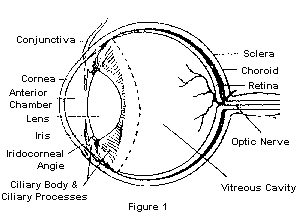A cataract is defined as any opacity (or opacities) of the lens of the eye. Such opacities may be quite small and interfere little with vision, or they may involve the entire lens causing blindness. Cataracts occur because something interferes with the normal function of lens fibers causing them to degenerate. Causes include inflammatory diseases, hereditary factors, aging changes, toxicities, and metabolic diseases such as diabetes mellitus.
Do all animals develop cataracts with age?
In general, no! In fact most animals should live their entire lives without developing cataracts. The lens does become thicker with age and thus appears grayer causing many people to mistake this change for a cataract. This normal aging process is called nuclear or lenticular sclerosis and does not impair vision other than making focusing on close objects more difficult. However some animals do develop cataracts and certain breeds of animals are afflicted with hereditary cataracts so that a significant percentage of the population may develop cataracts. This is especially true in dogs. Miniature schnauzers, cocker spaniels, poodles, Labrador retrievers and golden retrievers are just a few of the breeds which may be affected.
How do you treat cataracts?
There is no effective medical treatment for cataracts. However, when cataracts are caused by other diseases (e.g. diabetes, intraocular inflammations, etc.) the primary disease itself should be treated. As long as a cataract does not impair vision, no treatment is necessary; but when vision is poor, surgical removal may be considered. Cataract surgery is quite delicate and intensive postoperative care combined with the cooperation of the patient is essential for success.
Is surgery really necessary?
Cataract surgery is an elective procedure, and whether it is performed depends upon each individual owner and animal. Surgery should not be performed on eyes with negative ERG’s or with extensive scars and adhesions inside the eye. Some patients are poorer anesthetic risks than others, and some have poorer chances for success due to concurrent medical problems (diabetes, etc.).
Some cataracts become hypermature and clear by liquefaction and reabsorption of the lens proteins thus allowing return of vision. In a sense they break down or dissolve. This happens most often in young dogs (1-2 years old) with rapidly developing cataracts, and occurs in an estimated 1-2% of these dogs. The eye can be irritated by the reabsorbing lens protein, and may require medical treatment.
The most important thing to remember is that there is no need to hurry in making a decision. Cataracts are not painful and there are worse things than being blind. Consult with your veterinary ophthalmologist to find out more about the surgery.
What kind of post-surgical care is required?
After surgery the patient must be kept quiet, and no running or jumping is allowed. In general it is advisable to limit activity to areas with few obstacles so that the eye is not accidentally bumped.
Dogs should be allowed outside only for eliminations, and tight collars or leashes which put pressure around their necks should be avoided.
Medication is administered both orally and in the eye (drops and/or ointments) to control inflammation inside the eye, prevent infection, and to keep the pupil open. Initially treatment is administered 6 times daily and continues until inflammation subsides. The frequency of therapy is decreased as inflammation subsides and this varies for each individual. Usually therapy has been decreased to once daily by 4 weeks after surgery. The sutures used are absorbable and need not be removed. However, you should plan on at least 3 visits with us after surgery.

